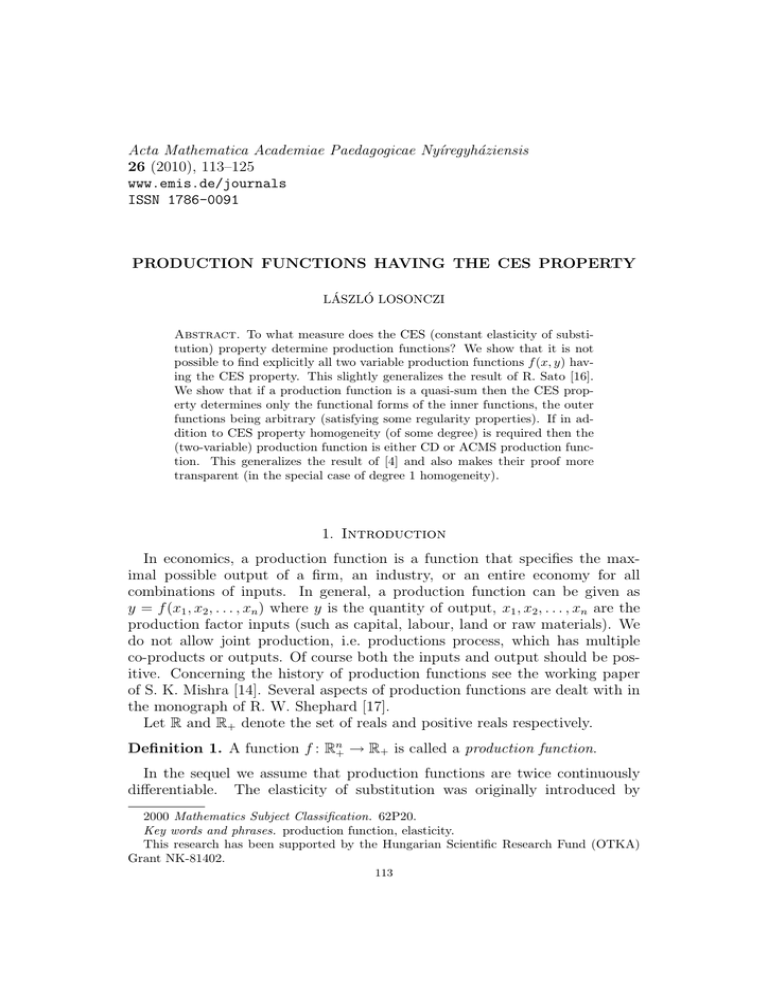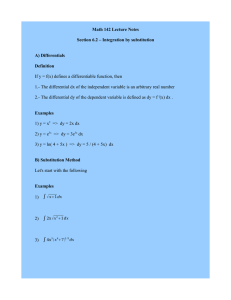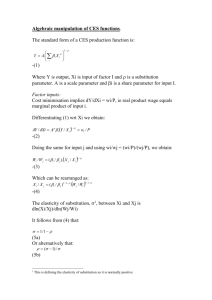Acta Mathematica Academiae Paedagogicae Ny´ıregyh´aziensis 26 (2010), 113–125 www.emis.de/journals ISSN 1786-0091
advertisement

Acta Mathematica Academiae Paedagogicae Nyı́regyháziensis
26 (2010), 113–125
www.emis.de/journals
ISSN 1786-0091
PRODUCTION FUNCTIONS HAVING THE CES PROPERTY
LÁSZLÓ LOSONCZI
Abstract. To what measure does the CES (constant elasticity of substitution) property determine production functions? We show that it is not
possible to find explicitly all two variable production functions f (x, y) having the CES property. This slightly generalizes the result of R. Sato [16].
We show that if a production function is a quasi-sum then the CES property determines only the functional forms of the inner functions, the outer
functions being arbitrary (satisfying some regularity properties). If in addition to CES property homogeneity (of some degree) is required then the
(two-variable) production function is either CD or ACMS production function. This generalizes the result of [4] and also makes their proof more
transparent (in the special case of degree 1 homogeneity).
1. Introduction
In economics, a production function is a function that specifies the maximal possible output of a firm, an industry, or an entire economy for all
combinations of inputs. In general, a production function can be given as
y = f (x1 , x2 , . . . , xn ) where y is the quantity of output, x1 , x2 , . . . , xn are the
production factor inputs (such as capital, labour, land or raw materials). We
do not allow joint production, i.e. productions process, which has multiple
co-products or outputs. Of course both the inputs and output should be positive. Concerning the history of production functions see the working paper
of S. K. Mishra [14]. Several aspects of production functions are dealt with in
the monograph of R. W. Shephard [17].
Let R and R+ denote the set of reals and positive reals respectively.
Definition 1. A function f : Rn+ → R+ is called a production function.
In the sequel we assume that production functions are twice continuously
differentiable. The elasticity of substitution was originally introduced by
2000 Mathematics Subject Classification. 62P20.
Key words and phrases. production function, elasticity.
This research has been supported by the Hungarian Scientific Research Fund (OTKA)
Grant NK-81402.
113
114
L. LOSONCZI
J. R. Hicks (1932) [10] (in case of two inputs) for the purpose of analyzing changes in the income shares of labor and capital. R. G. D. Allen and
J. R. Hicks (1934) [3] suggested two generalizations of Hicks’ original two variable elasticity concept. The first concept which we call Hicks’ elasticity of
substitution is defined as follows.
Definition 2. Let f : Rn+ → R+ be a production function with non-vanishing
first partial derivatives. The function
(1)
Hij (x) = −
fii
(fi )2
1
x i fi
+
−
2fij
fi fj
1
x j fj
+
fjj
(fj )2
(x ∈ Rn+ , i, j = 1, . . . , n, i 6= j)
(where the subscripts of f denote partial derivatives i.e.
∂ 2f
∂f
, fij =
,
∂xi
∂xi ∂xj
all partial derivatives are taken at the point x and the denominator is assumed
to be different from zero) is called the Hicks’ elasticity of substitution of the ith
production variable (factor) with respect to the jth production variable (factor).
fi =
The other concept (thoroughly investigated by R. G. D. Allen [2], and
H. Uzawa [20] is more complicated.
Definition 3. Let f : Rn+ → R+ be a production function. The function
(2)
x1 f1 + x2 f2 + · · · + xn fn Fij
(x ∈ Rn+ , i, j = 1, . . . , n, i 6= j)
Aij (x) = −
xi xj
F
where F is the determinant of the bordered matrix
0 f1 . . . fn
f1 f11 . . . f1n
(3)
M =
... ... . . . ...
fn fn1 . . . fnn
and Fij is the co-factor of the element fij in the determinant F (F 6= 0 is
assumed and all derivatives are taken at the point x) is called the Allen’s
elasticity of substitution of the ith production variable (factor) with respect to
the jth production variable (factor).
It is a simple calculation to show that in case of two variables Hicks’ elasticity
of substitution coincides with Allen’s elasticity of substitution.
Definition 4. A twice differentiable production function f : Rn+ → R+ is said
to satisfy the CES (constant elasticity of substitution)-property if there is a
constant σ ∈ R, σ 6= 0 such that
(4)
Hij (x) = σ
(x ∈ Rn+ , i, j = 1, . . . , n, i 6= j).
In the sequel we discuss that to what measure does the CES property (4)
determine the production function.
PRODUCTION FUNCTIONS HAVING THE CES PROPERTY
115
2. Cobb-Douglas and Arrow-Chenery-Minhas-Solow type
production functions
C. W. Cobb and P. H. Douglas [6] studied how the distribution of the national income can be described by help of production functions. The outcome
of their study was the production function
f (x) = Cxα1 1 · · · · · xαnn
(x ∈ Rn+ )
where C > 0, αi 6= 0 (i = 1, . . . , n) are constants satisfying α :=
n
P
αi 6= 0. We
i=1
call this Cobb-Douglas (or CD) production function.
In 1961 K. J. Arrow, H. B. Chenery, B. S. Minhas and R. M. Solow [4]
introduced a new production function
m
m
f (x) = (β1 x1β + · · · + βn xnβ )β
(x ∈ Rn+ )
where βi > 0 (i = 1, . . . , n), m 6= 0, β 6= 0 are real constants. We shall
refer to this function as Arrow-Chenery-Minhas-Solow (or ACMS) production
function.
The CD and ACMS production functions have the CES property, namely
1
as it is easy to check Hij (x) = 1 for the CD functions and Hij (x) =
for
1− m
β
6= 1, for m
= 1 the denominator of Hij
the ACMS production functions if m
β
β
is zero, hence it is not defined.
3. Homogeneous, sub- and superhomogeneous functions
Definition 5. A function F : Rn+ → R+ is called is said to be homogeneous of
degree m ∈ R if
F (tx) = tm F (x)
holds for all x ∈ Rn+ , t > 0.
Definition 6. A function F : Rn+ → R+ is called is said to be subhomogeneous
of degree m ∈ R if
F (tx) ≤ tm F (x)
holds for all x ∈ Rn+ and for all t > 1. The function F is called superhomogeneous of degree m ∈ R if the reverse inequality holds.
Homogeneous (sub and superhomogeneous) functions of degree 1 will simply
be called homogeneous (sub and superhomogeneous) functions.
If F is a production function, then in economy also the terms constant
return to scale, decreasing and increasing return to scale are used to designate
homogeneous, subhomogeneous and superhomogeneous (production) functions
respectively.
It is well-known that differentiable homogeneous functions F of degree m
can be characterized by Euler’s PDE
x1 Fx1 (x) + · · · + xn Fxn (x) = mF (x) (x ∈ Rn+ ).
116
L. LOSONCZI
It is not so much known, that similar characterizations hold for sub- and
superhomogeneous function (compare with L. Losonczi [11]).
Theorem 7. Suppose that F : Rn+ → R+ is a differentiable function on its
domain. F is subhomogeneous of degree m, i.e.
F (tx) ≤ tm F (x)
(5)
holds for all x ∈ Rn+ and for all t > 1 if and only if
x1 Fx1 (x) + · · · + xn Fxn (x) ≤ mF (x) (x ∈ Rn+ ).
(6)
F is superhomogeneous of degree m, i.e. the reverse inequality of (5) holds if
and only if the reverse of (6) is satisfied. If strict inequality holds in (6) (or
in its reverse) then also (5) (or its reverse) is satisfied with strict inequality.
Remark 1. (5) (or its reverse) holds for x ∈ Rn+ , t ∈]0, 1[ if and only if the
reverse of (6) (or (6)) is satisfied.
Proof. We prove the statement only for subhomogeneous functions, the superhomogeneous case is analogous.
Necessity. Deducting F from (5), dividing by t − 1 > 0 and taking the limit
t → 1 + 0 we obtain (6).
Sufficiency. Replace in (6) x by tx and rearrange it as
tx1 Fx1 (tx) + · · · + txn Fxn (tx)
≤m
F (tx)
where t > 1. This equation can be rewritten as
d
d
m
t (ln F (tx)) ≤ m, or
(ln F (tx)) ≤ .
dt
dt
t
Integrating the latter inequality from t = 1 to t > 1 and omitting the ln sign
we obtain (5), completing the proof of sufficiency.
The statement concerning strict inequalities is obvious.
¤
4. The most general two variable CES function
Suppose that f : R2+ → R+ is a two variable CES production function, then
(7)
−
f11
(f1 )2
1
x1 f1
+
1
x2 f2
−
2f12
f1 f2
+
f22
(f2 )2
=σ
(x1 , x2 ∈ R+ )
where σ ∈ R, σ 6= 0 is a constant. (7) is partial differential equation (PDE) of
second order which can be reduced to two first order equations. We shall find
the general solution of the first equation. We partially follow R. Sato [16] who
found the solution of a special Cauchy problem for the said equation. The left
hand side of (7) can be written as
−
f11
(f1 )2
1
x 1 f1
+
−
2f12
f1 f2
1
x2 f2
+
f22
(f2 )2
=
³
x1 f1 + x2 f2
x1 x2 − f11f1f2 + 2f12 −
f22 f1
f2
´=
x + x2 u
´
³1
1 ∂u
∂u
−
x1 x2 ∂x
u ∂x2
1
PRODUCTION FUNCTIONS HAVING THE CES PROPERTY
117
where
f1 (x1 , x2 )
(x1 , x2 ∈ R+ ).
f2 (x1 , x2 )
By (7) the new unknown function u satisfies the first order PDE
u(x1 , x2 ) :=
1 ∂u
u
1
∂u
−
=
+
.
∂x1 u ∂x2
σx1 σx2
This PDE is simplified if we introduce the function v = ln u provided that
u(x1 , x2 ) > 0 (otherwise, if u(x1 , x2 ) < 0, we use the substitution v = ln(−u)).
Restricting ourselves to the first case, the transformed equation reads
ev
∂v
∂v
ev
1
−
=
+
,
∂x1 ∂x2
σx1 σx2
or
1´
1´
∂ ³
∂ ³
v − ln x1σ =
v + ln x2σ .
∂x1
∂x2
This equation is further simplified if we use the new unknown function
ev
1
1
w(x1 , x2 ) := v(x1 , x2 ) − ln x1σ + ln x2σ .
Then
µ
v
w
e =e
x1
x2
¶ σ1
,
1´
∂ ³
∂w
σ
v − ln x1 =
,
∂x1
∂x1
1´
∂ ³
∂w
σ
v + ln x2 =
∂x2
∂x2
hence
µ
(8)
w
e
x1
x2
¶ σ1
∂w
∂w
−
= 0.
∂x1 ∂x2
(8) is a first order homogeneous quasi-linear partial differential equation in two
variables. Taking its general solution in implicit form Φ(x1 , x2 , w) = 0 it is
known (see [19, pp. 279–283]), that for Φ the linear homogeneous PDE
µ ¶ σ1
x1
∂Φ
∂Φ
∂Φ
w
e
−
+0
=0
x2
∂x1 ∂x2
∂w
holds. Its characteristic system is
e
or
dw
dx1
dx2
³ ´ σ1 = −1 = 0
w x1
x2
µ ¶ σ1
dx1
dw
x1
w
= 0,
= −e
.
dx2
dx2
x2
First we find two independent first integrals of this system of ordinary differential equations. From the first equation we get w = C0 (C0 is an arbitrary
118
L. LOSONCZI
constant) then with eC0 = C1 > 0 separating the variables in the second
equation we obtain
dx1
dx2
1 = −C1
1 .
x1σ
x2σ
Integrating we get
ln x1 = −C1 ln x2 + C2
(9)
1− 1
x1 σ
=
1− 1
−C1 x2 σ
+ C2
if σ = 1
if σ 6= 1.
The first integrals are the solutions for C1 , C2 of the system consisting of (9)
and ew = C1 . These are C1 = ew , C2 = ln x1 + ew ln x2 if σ = 1 and C1 =
1− 1
1− 1
ew , C2 = x1 σ + ew x2 σ if σ 6= 1. Finally the general solution of (8)
Φ(ew , ln x1 + ew ln x2 ) = 0,
1− σ1
Φ(ew , x1
1− σ1
+ ew x2
if σ = 1,
) = 0,
if σ 6= 1,
where Φ is an arbitrary differentiable function. Going back to the original
variables we obtain
µ ³ ´1
¶
³ ´ σ1
f1
f1
x2 σ
x2
Φ f2 x1 , ln x1 + f2 x1
ln x2 = 0,
if σ = 1
(10)
µ
Φ
f1
f2
³ ´ σ1
x2
x1
,
1− 1
x1 σ
+
f1
f2
³ ´ σ1
x2
x1
1− 1
x2 σ
¶
= 0,
if σ 6= 1
The next step in finding the production function f would be to solve (10) for the
ratio ff12 as a function of x1 , x2 i.e. find a function G such that ff21 = G(x1 , x2 ).
Then solving the second linear PDE
∂f
∂f
− G(x1 , x2 )
=0
∂x1
∂x2
we obtain the the most general CES functions f .
Unfortunately we cannot find all solutions ff12 from (10), as this ratio appears
in both variables of Φ. We can however find several families of Φ for which the
solution can be found.
For CES functions of more than two variables the situation is even more
complicated.
5. Quasi-sum form CES production functions
Definition 8. A function f : Rn+ → R+ is called a quasi-sum, if there exist
continuous strict monotone functions gi : R+ → R (i = 1, . . . , n) and there
exist an interval I ⊆ R of positive length and a continuous strict monotone
function g : I → R+ such that for every x = (x1 , . . . , xn ) ∈ Rn+ we have
g1 (x1 ) + · · · + gn (xn ) ∈ I and
(11)
f (x) = g (g1 (x1 ) + · · · + gn (xn )) .
PRODUCTION FUNCTIONS HAVING THE CES PROPERTY
119
The justification for studying production functions of quasi-sum form is that
these functions appear as solutions of the general bisymmetry equation and
they are related to the problem of consistent aggregation, see J. Aczél and
Gy. Maksa [1], Gy. Maksa [13].
Our first observation is that if a production function is of quasi-sum form
(11) then its Hicks’ elasticity of substitution of the ith production variable
with respect to the jth production variable does not depend on the function g.
Write h(x) = g1 (x1 ) + · · · + gn (xn ) then
f (x) = g (h(x)) = g (g1 (x1 ) + · · · + gn (xn ))
(x ∈ Rn+ ).
A simple calculation shows that
fxi (x) = g 0 (h(x)) gi0 (xi )
fxi xi (x) = g 00 (h(x)) (gi0 (xi ))2 + g 0 (h(x)) gi00 (xi )
fxi xj (x) = g 00 (h(x)) gi0 (xi )gj0 (xj )
thus
(12) Hij (x) =
− xi g01(h)g0 −
g 00 (h)(gi0 )2 +g 0 (h)gi00
(g 0 (h)gi0 )2
−
xj g
i
2g 00 (h)gi0 gj0
(g 0 (h))2 gi0 gj0
1
0 (h)g 0
j
g 00 (h)(gj0 )2 +g 0 (h)gj00
(g 0 (h)gj0 )2
+
=
− xi1g0 −
i
gi00
(gi0 )2
+
1
xj gj0
gj00
(gj0 )2
where the derivatives of gi (i = 1, . . . , n) are taken at the point xi and h is
taken at x. This proves our claim.
For quasi sums however the CES property determines the functional forms
of the inner functions gi .
Theorem 9. Suppose that the production function f : Rn+ → R+ is of quasisum form (11) where the functions g, gi (i = 1, . . . , n) are twice differentiable
and have non-vanishing first derivatives. If f satisfies the CES-property, then
the functions gi (i = 1, . . . , n) have the following forms
1
σx1− σ
+ Di ,
if σ 6= 1,
Ci (σ − 1)
(13)
gi (x) =
ln x
+ Di ,
if σ = 1,
Ci
where Ci , Di are arbitrary nonzero constants.
If n = 2, σ 6= 1 then, in addition to the functions (13), g1 , g2 may have the
form
¯
¯
¯
¯
¯
¯ −σd1 x1− σ1
¯
¯ σd1 x1− σ1
ln ¯ σ−1 +C2 ¯
ln ¯ σ−1 +C1 ¯
+D1 , g2 (x) =
+D2 ,
(14)
g1 (x) =
d1
−d1
120
L. LOSONCZI
where d1 6= 0, D1 , D2 are arbitrary constants, C1 , C2 are constants satisfying
the conditions
(σ − 1)
(σ − 1)
(15)
sign C1 = sign
, and sign C2 = − sign
.
σd1
σd1
Conversely, if gi have the forms (13), (14) (with (15) satisfied) then (4) holds.
Proof. By the identity
d
g 00 (x)
=−
0
2
(g (x))
dx
we can rewrite (12) as
µ
1
0
g (x)
¶
µ
¶
1 1
1 1
−
+
xi gi0 xj gj0
Hij (x) = Ã !0 Ã !0 .
1
1
+
0
gi
gj0
This shows that the substitutions ki (xi ) :=
1
gi0 (xi )
will simplify our formulae.
Indeed, by the help of ki the equation (4) goes over into
µ
¶
1
1
0
0
σki (xi ) − ki (xi ) = − σkj (xj ) − kj (xj ) .
xi
xj
Here the right hand side depends only on xj while the left hand side depends
only on xi , hence both sides must be constant (depending only the subscript
i). Thus we conclude that
1
(16)
ki0 (xi ) −
ki (xi ) = di (i = 1, . . . , n).
σxi
For the constants di we have di + dj = 0 if i, j ∈ {1, . . . , n}, i 6= j.
If n = 2 then we have only one equation: d1 + d2 = 0, hence d2 = −d1 , with
arbitrary d1 ∈ R.
If n ≥ 3 then all di ’s must be zero, as d1 + d2 = d1 + d3 = · · · = d1 + dn = 0,
hence d2 = d3 = · · · = dn = −d1 . From d2 + d3 = 0 we get d1 = 0, thus
d2 = · · · = dn = 0.
Thus we proved that (4) holds if and only if
Z
dx
, (x ∈ R+ , i = 1, . . . , n)
gi (x) =
ki (x)
where ki satisfy (16), with d1 ∈ R, d2 = −d1 , if n = 2, and d1 = · · · = dn = 0,
if n ≥ 3.
It is a simple exercise to show that the general solution of the linear inhomogeneous first order differential equation
1
k(x) = d
(x ∈ I ⊆ R+ )
k 0 (x) −
σx
PRODUCTION FUNCTIONS HAVING THE CES PROPERTY
is
1
σdx
σ − 1 + Cx σ ,
k(x) =
dx ln x + Cx,
121
if σ 6= 1,
if σ = 1,
where C ∈ R is an arbitrary constant. Further, for d 6= 0 using the substitu1
σdx1− σ
tions u =
+ C resp. u = d ln x + C in the integrations we have
σ−1
1
σx1− σ
+ D,
if d = 0, C 6= 0, σ 6= 1,
C(σ − 1)
ln x
+ D,
if d = 0, C 6= 0, σ = 1,
Z
C
dx
(17)
=
¯ 1− 1
¯
k(x)
¯ σdx σ
¯
ln ¯ σ−1 + C ¯
+ D, if d 6= 0, σ 6= 1,
d
ln |d ln x + C| + D,
if d 6= 0, σ = 1,
d
where D ∈ R is an arbitrary constant.
If n = 2 then, in agreement with the previous calculations, we get g1 , g2
from (11) by putting into it C = C1 , C2 ; D = D1 , D2 ; d = d1 , −d1 respectively.
Thus, assuming d1 6= 0 we obtain that
¯
¯
¯
¯
¯ x1− σ1
¯
¯ 1 x1− σ1
¯
ln ¯ σd1σ−1
+C1 ¯
ln ¯ −σdσ−1
+C2 ¯
g1 (x) =
+D1 , g2 (x) =
+D2 ,
if σ 6= 1,
d1
−d1
g1 (x) =
ln |−d1 ln x + C2 |
ln |d1 ln x + C1 |
+ D1 , g2 (x) =
+ D2 ,
d1
−d1
if σ = 1.
These functions should be defined for all positive numbers. This requirement
excludes the solutions g1 , g2 for σ = 1, as in this case the function x →
d1 ln x + C1 always has a positive zero x0 = e−C1 /d1 thus g1 is not defined at x0 .
For σ 6= 1 the situation is different. In this case g1 , g2 are defined for all positive
1
1
1− σ
x1− σ
1x
+C1 , x → −σdσ−1
+C2 do
numbers if and only if the functions x → σd1σ−1
C1 (σ−1)
C2 (σ−1)
not have positive zeros, i.e. if − σd1 < 0, and σd1 < 0, or if
sign C1 = sign
(σ − 1)
,
σd1
hold, which is exactly (8).
and
sign C2 = − sign
(σ − 1)
σd1
¤
122
L. LOSONCZI
6. Homogeneous CES production functions
Here we show that CES property and homogeneity (of some degree ) explicitly determine the production functions, moreover they are either CD or ACMS
production functions. This generalizes and somewhat clarifies analogous result
of [4].
Theorem 10. Suppose that P : R2+ → R+ is a twice differentiable two-variable
production function, homogeneous of degree m 6= 0 and satisfying (7). Then
Cxα y m−α ,
if σ = 1
(18)
P (x, y) = ³
´β
β1 x mβ + β2 y mβ , if σ 6= 1.
where α 6= 0 is arbitrary nonzero constant such that m − α 6= 0 holds, C, β1 , β2
mσ
m
are arbitrary positive constants, β =
6= 0 (and due to this
6= 1).
σ−1
β
Remark 2. If P is homogeneous of degree zero then by the homogeneity equation xPx (x, y) + yPy (x, y) = 0. Hence xP1 x + yP1 y = 0 which makes the function
Hij indeterminate. Thus the assumption m 6= 0 in Theorem 10 is natural.
Remark 3. (18) shows that for σ = 1 the function P is a CD function while
for σ 6= 1 our production function P is an ACMS function.
Proof. For the sake of simplicity we shall denote the variables of P by x, y.
Then (7) has the form
(19)
σ=−
1
+ yPy 1(x,y)
xPx (x,y)
(x,y)
Pxx (x,y)
xy (x,y)
− Px2P
+ (PPyyy(x,y))
2
(Px (x,y))2
(x,y)Py (x,y)
.
As P is homogeneous of degree m it satisfies the partial differential equation
(20)
xPx (x, y) + yPy (x, y) = mP (x, y).
Differentiating (20) with respect to x we get
Px + xPxx + yPyx = mPx
where here and in the following P and its derivatives are taken at the point
(x, y). Hence
m−1
y
Px
Pxx = − Pyx +
x
x
x
m−1
and similarly Pyy = − Pxy +
Py
y
y
Substituting these into (19) we obtain that
´
³
1
1
− xPx + yPy
σ=
´2
³
³
−xyPxy xP1 x + yP1 y + (m − 1) xP1 x +
1
yPy
´.
PRODUCTION FUNCTIONS HAVING THE CES PROPERTY
123
Simplifying by the numerator we get that
¶
µ
1
1
1
xyPxy
+
=m−1+ .
xPx yPy
σ
Using again the homogeneity equation we have
1
xPx
+ yP1 y =
mP
xPx yPy
thus finally
P Pxy
1
1
=1−
+
Px Py
m σm
(21)
Case 1: σ = 1. Now we can rewrite (21) in the form
P Pxy − Px Py
= 0, or (ln P )xy = 0,
P2
hence by integration we conclude that there exist differentiable functions g, h
such that
ln P (x, y) = g(x) + h(y), P (x, y) = eg(x)+h(y) .
Substituting P into the homogeneity equation (20) we obtain
xg 0 (x)eg(x)+h(y) + yh0 (y)eg(x)+h(y) = meg(x)+h(y) ,
or
xg 0 (x) = m − yh0 (y).
Here the right hand side depends only on x, while the left one only on y, thus
both sides must be a constant α and g, h have to satisfy the equations
α
m−α
g 0 (x) = ,
h0 (y) =
.
x
y
These equations imply that α 6= 0, m − α 6= 0 otherwise the partial derivatives
Px , Py would be zero, making the function Hij indeterminate.
Integrating we obtain g(x) = α ln x + D1 , h(y) = (m − α) ln y + D2 where
D1 , D2 ∈ R are arbitrary constants, and
P (x, y) = eg(x)+h(y) = eα ln x+D1 +(m−α) ln y+D2 = eD1 +D2 xα y m−α = Cxα y m−α
where C := eD1 +D2 is an arbitrary positive constant. This proves (18) in the
case σ = 1.
Case 2: σ 6= 1. Let H be defined by P (x, y) = H(x, y)β , where β is a
constant to be determined later. Substituting the derivatives
Px = βH β−1 Hx , Py = βH β−1 Hy , Pxy = β(β − 1)H β−2 Hx Hy + βH β−1 Hxy
of P into (21) we get after some simplifications that
1 HHxy
1
1
1
+
=1−
+
.
β β Hx Hy
m σm
mσ
m
Let β =
then β 6= 0 as m 6= 0, σ 6= 0 further
6 1 otherwise 1 =
=
σ−1
β
σ
which is impossible. (22) simplifies to Hxy (x, y) = 0. Thus there exist
σ−1
(22)
1−
124
L. LOSONCZI
differentiable functions g, h such that
H(x, y) = g(x) + h(y),
hence P (x, y) = (g(x) + h(y))β .
Substituting P into the homogeneity equation (20) we obtain after some simplifications that
βxg 0 (x) − mg(x) = mh(y) − βyh0 (y).
Here, again, the right hand side depends only on x, while the left one only on
y, thus both sides must be a constant α and g, h have to satisfy the equations
m
α
m
α
g 0 (x) −
g(x) =
,
h0 (y) −
h(y) = − .
βx
βx
βy
βy
The general solutions of these linear differential equations are
m
m
−α
α
h(y) =
g(x) =
+ β1 x β
+ β2 y β ,
m
m
where β1 , β2 ∈ R are arbitrary constants, and
³
´
m
m β
P (x, y) = (g(x) + h(y))β = β1 x β + β2 y β .
Here β1 , β2 must be positive, otherwise P would not be defined for all positive
x, y.
¤
7. Closing remarks
For production functions of n > 2 variables the approach in section 6 does
not work, as the CES property involves partial derivatives with respect to two
variables while Euler’s PDE characterizing homogeneous functions involves all
partial derivatives. There were several attempts to extend the two variable
result to more variables, see e.g. D. McFadden [8], H. Uzawa [20]. CD and
ACMS production functions (of several variables) have been characterized by
the homogeneity (of some degree) and quasi-sum (or quasi-linear) form, see
W. Eichorn [7], B. Nyul [12], F. Stehling [18].
The Hick’s elasticity of substitution has been generalized into several directions, see among others R. Färe and L. Jansson [9], C. Blackorby and
R. R. Russell [5], N. S. Revankar [15].
References
[1] J. Aczél, Gy. Maksa, Solution of the rectangular m × n generalized bisymmetry equation
and of the problem of consistent aggregation, J. Math. Anal. Appl. Vol 203, (1996),
104-126.
[2] R. G. D. Allen, Mathematical Analysis for Economists, London, Macmillan, 1938.
[3] R. G. D. Allen, J. R. Hicks, A Reconsideration of the Theory of Value, Pt. II, Economica,
February-May 1934, 1, N.S. 196-219.
[4] K. J. Arrow, H. B. Chenery, B. S. Minhas, R. M. Solow, Capital-Labor Substitution and
Economic Efficiency, The Review of Economics and Statistics, Vol. 43, No. 3 (Aug.,
1961), 225-250.
PRODUCTION FUNCTIONS HAVING THE CES PROPERTY
125
[5] C. Blackorby and R. R. Russell, Will the Real Elasticity of Substitution Please Stand
Up? (A comparison of the Allen/Uzawa and Morishima Elasticities), The American
Economic Review, Vol. 79, No. 4 (1989), 882-888.
[6] C. W. Cobb, P. H. Douglas, A theory of production. The American Economic Reviewv
Vol. 18 (1928), 139-165.
[7] W. Eichorn, Characterization of CES production functions by quasilinearity, in Production Theory (W. Eichorn, R. Henn, O. Opitz and R. W. Shephard eds.), Springer-Verlag,
1974, pp. 21-33.
[8] D. McFadden, Constant Elasticity of Substitution Production Functions, The Review
of Economic Studies, Vol. 30, No. 2 (Jun., 1963), 73-83.
[9] R. Färe, L. Jansson, On VES and WDI production functions, Internat. Econ. Review,
vol. 16, no. 3, (1975), 745-750.
[10] J. R. Hicks, Theory of Wages, London, Macmillan, 1932.
[11] L. Losonczi, Subhomogene Mittelwerte, Acta Math. Acad. Sci. Hung. Vol. 22, No. 1-2,
(1973), 187-195.
[12] B. Nyul, Production functions and their characterizations, (in Hungarian), Alk. Mat.
Lapok, Vol. 26 (2009), 351–363 .
[13] Gy. Maksa, Solution of the generalized bisymmetry type equations without surjectivity
assumptions, Aeq. Math. Vol. 57 (1999), 50-74.
[14] S. K. Mishra, A Brief History of Production Functions, Working Paper Series Social
Science Research Network (SSRN), http://ssrn.com/abstract=1020577.
[15] N. S. Revankar, A Class of Variable Elasticity of Substitution Production Functions,
Econometrica, Vol. 39, No. 1, (1971), 61-71.
[16] R. Sato, The Most General Class of CES Functions, Econometrica, Vol. 43, No. 5/6
(Sep. - Nov., 1975), 999-1003.
[17] R. W. Shephard, Cost and Production Functions, Princeton, New Jersey, Princeton
University Press, 1970.
[18] F. Stehling, Eine neue Charakterisierung der CD- und ACMS-Produktiosfunktionen,
Operations Research-Verfahren 21 (1975), 222-238.
[19] K. Sydsæter, P. Hammond, A. Seierstad, A. Strøm, Further Mathematics for Economic
Analysis, Prentice Hall (2008).
[20] H. Uzawa, Production Functions with Constant Elasticities of Substitution, The Review
of Economic Studies, Vol. 29, No. 4 (Oct., 1962), 291-299.
Received July 4, 2009.
Faculty of Economics,
University of Debrecen,
H-4028 Debrecen, Kassai út 26, Hungary,
E-mail address: losi@math.klte.hu







